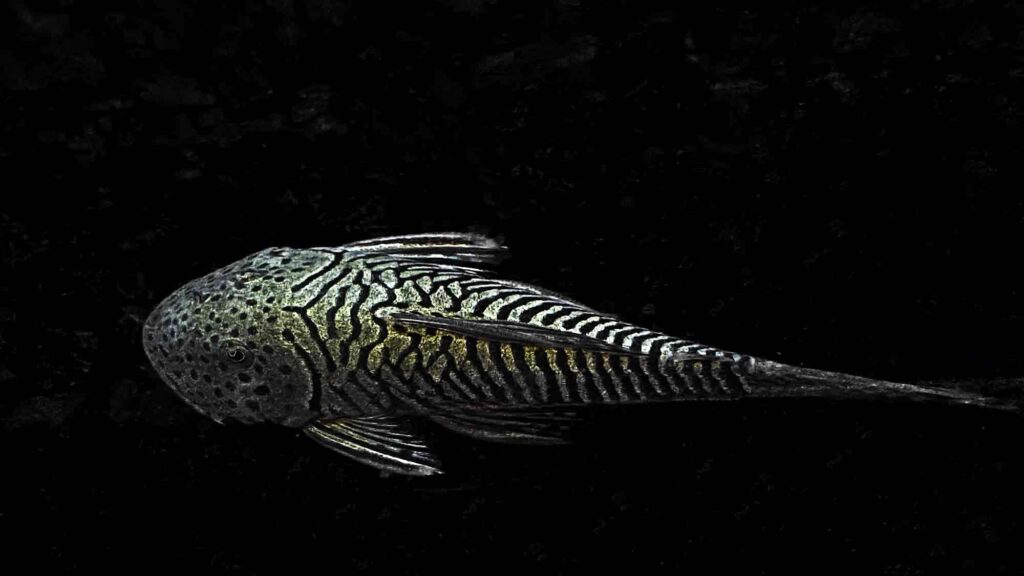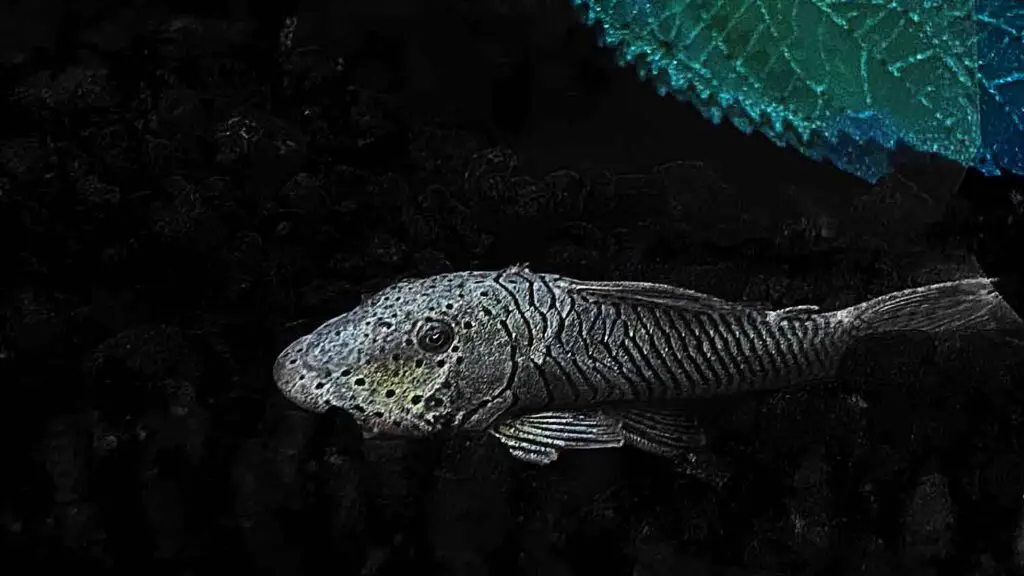Rubber Lip Pleco (Chaetostoma milesi) are unique-looking freshwater fish that are famous for their pleco mold and their huge lips. They are a small pleco species that do not need a lot of attention and care when it comes to keeping them. Their hardy nature makes them a great fit for most beginner aquarists looking to start keeping plecos. However, they will still need specific water conditions to live a long and healthy life. While most buy them to eat alage grown in the tank, you will still need to feed them and provide them the right tank setup.
This guide on Rubber Lip Pleco care will provide you with all the information you need about this species. By the end of this guide you will be able to confidently keep this fish in your aquarium.
Species Profile & Overview
Rubber Lip Pleco are naturally found in different rivers of Amazon Basin in Colombia. In the past these fish were very famous for their ability to eat algae, but with the introduction of different types of plecos in the aquarium hobby, they slowly lost their fame. However, they are still available in most pet stores and their lower price range still attracts aquarium owners.
This fish, like all members of the Loricariidae family. have an armored back that protects the fish from other predators. Their back is designed with simple and uniformed strips and dots. They are mainly light gray in color and have darker dots and stripes on their body. Their round and cylinder shaped body along with their bony back and their unique patterns will help them survive in nature.
Almost all the Rubber Lip Pleco, sold in pet stores, are being collected directly from the wild. This is because they are widely available in the wild and are not as pricey as other more colorful plecos. So not many breeders have tried to breed them in captivity. The Rubber Lip Pleco is not only beautiful but they will do the job of cleaning algae and will not grow too big. This makes them an ideal fish for most medium to large community tanks.
Appearance

As mentioned, Rubber Lip Pleco are beautiful fish belonging to the Loricariidae family. They have the same armored backs and soft bellies as the other fish in this family.
They have a thick head and body that gradually becomes thinner as it flows approaches the tail fin. The eyes are located on the back of the head where they can easily monitor their surroundings.

As depicted in the illustration above, they have eight fins that help them swim and maneuver around. Their translucent fins are broad and form a triangular shape.
This fish has a light grey color with darker stripes and dots on its back. Depending on the variety of the rubber lip, they have strips covering their back and dots covering their body. But some might come all dotted.
As they grow they seem to slightly lose their stripes and become more solid grey but will keep the dot patterns.
Adult Size
When fully grown, the Rubber Lip Pleco size is about 5.1 inches in length. Females tend to stay smaller and less bulkier compared to the males but exceptions can be found as well. Their small size makes them a good choice for medium size aquariums. Many species of plecos get very large and outgrow their tank but luckily this fish stays small.
Lifespan
In mint conditions, Rubber Lip Pleco Pleco lifespan is about 10-12 years. This means they need a long term commitment and care if you want to have them in your tank. Throughout this time, you will have to provide them with a good diet and clean water. Stable water parameters, regular maintenance and a proper diet will help this fish to reach its expected life.
Behavior and Temperament
Rubber Lip Plecos are a docile and shy species that spend most of their time lurking behind and under rocks or other caves or decorations in the tank. They are mainly active at night and this is when they look for food in the tank.
Depending on how your aquarium decorations are placed, it’s possible that you won’t see these shy fish much during the day and when the lights are on. Still, that doesn’t mean they won’t come out during the day. even during the day, there will be occasions when you will look down into the tank and watch your fish swimming on the substrate and investigating the tank. This usually occurs when the fish have reached a level of comfort within the tank in which they feel safe enough to leave their hiding spot.
When compared to other aquarium species, these guys tend to become a little territorial. This is especially true of males; when you put multiple bottom-dwelling fish in the tank. Males will compete and fight with other fish over caves and other hiding places.
You can stop this aggression by giving them a bigger fish tank or by removing some of the bottom-dwelling fish. Make sure your tank has enough caves and crevasses where the plecos can hide so they don’t get stressed or fight with each other.

Rubber Lip Pleco Care
Rubber Lip Pleco care is not very difficult. Even beginner fish keepers can care for them in their tanks. Even so, the best way to ensure that they remain in good health is to recreate the natural environment they live in the wild. This fish thrives in environments that have clean and warm water with a variety of foods to choose from.
The following are some concepts that you should follow in order to give your Rubber Lip Pleco the most suitable environment possible.
Tank Size
The minimum tank size for a single Rubber Lip Pleco is 30 gallons. Though juveniles can thrive in smaller aquariums, you will soon need to make upgrades as they grow.
However, if it’s possible, we recommend having a tank that is a little bit larger. Large tanks are easier to maintain and will keep more consistent parameters which is a plus point. Especially if you’re planning on adding more fish to the tank.
These fish require more floor area, which larger aquariums inevitably provide. When they have enough floor space they will show their true natural behaviors and will not fight with other fish over territory.
In an ideal world, a square tank with more bottom area is the best choice for these fish. The height of the water doesn’t matter that much as they stay at the bottom at all times. Therefore, aquariums that are wider are preferable to taller aquariums.
Tank Setup
In order to provide a natural environment for Rubber Lip Pleco in your aquarium, you will need to pay special attention to the bottom of the tank. These bottom-dwelling fish are shy and choose to hide under ornamentation and in the caves.
To give your plecos a sense of security during the day, you will need to add a few caves to your tank. There are a variety of prefabricated caves on the market that are designed with plecos in mind.
In addition to caves, you will need to stock your tank with a large number of rocks and driftwood objects to create a wider variety of shaded areas and hiding places. Since the caves and other hiding places are naturally dark, the pleco will feel safe and protected from predatory fish.
The native habitat of the Rubber Lip Pleco comprises a fine muddy and sandy substrate. In your aquarium, you can use sand as your substrate if you want your fish to feel at home. By doing this, you are giving your fish a comfortable tank bed that will not hut its soft belly. You can also use smaller pea gravel substrates; your fish’s belly won’t be harmed by their circular, cornerless design but are not as comfortable as sand.
Having plants in the tank is essential for maintaining a balanced ecosystem. When you add aquatic plants to your fish tank, not only will they help filter out harmful substances, but they will also give your fish a safe place to hide. We recommend adding plants to your aquarium to enhance both its aesthetics and its functionality.
Lighting
If you don’t have any live plants, it’s best to keep the lights low, as Rubber Lip Pleco thrives in the shade. If you have live plants, try to pick your light according to the plant’s needs but increase the number of decorations and hiding spots so your pleco can hide when lights are on.
Water Parameters
The Rubber-Lipped Pleco is native to warm rivers that have high levels of oxygen. These rivers are rich with decaying plant matter, driftwood, and live plants that serve as natural sources of nutrition for the animals that live there. The decaying driftwoods will cause the water to become slightly soft and acidic.
However, these fish can endure a larger variety of water parameters than they do in nature. The following are the minimum and recommended tank parameters for keeping Rubber Lip Pleco plecos:
- Temperature: 72 – 82 Degrees Fahrenheit
- PH: 6 – 7.5
- TDS: 60 – 150 PPM
If the pH of your tap water is neutral, we strongly advise you to not alter the ph in any way. Consistency is the key to the survival of these fish. Frequent water changes will keep your tank from fluctuating water parameters.
Plecos, in contrast to other fish, can tolerate significant water changes of up to 90% when the TDS(Total Dissolved Solids) of your tap water and tank water are similar. The TDS meter will show you how much dissolved solids are present in the water. When the TDS crosses the above-mentioned range you can perform a water change.
Filter System
In general, plecos produce a significant amount of waste, and the Rubber Lip Pleco is not an exception. Because of this, you will need to make use of a powerful filter to ensure that your water is spotless at all times. Since ammonia surges pose a significant threat to Rubber Lip Pleco plecos, you will need to install a filtration system that is rated 2 or 3 times the size of your aquarium.

Common Diseases and Prevention
Even though it is a hardy species, the Rubber Lip Pleco is susceptible to contracting infections that are commonly found in aquarium hobby. The environment that your fish call home (the aquarium) is a miniature version of the natural world outside. This means that infections will be able to easily and quickly spread among the fish.
Fin rot, ich, and internal worms are the most common diseases for Rubber Lip Plecos. Luckily these diseases are treatable. If this ever happens to your fish you can check your local fish store for medications to treat each.
The best form of treatment is prevention! You should make it a habit to clean your aquarium on a regular basis and check the water’s parameters on occasion. To keep your fish healthy, you should perform regular water changes and feed them nutritious food. You should never introduce new fish into your aquarium without first adequately quarantining them. By doing so, you can lessen the likelihood that diseases will spread in your tank, allowing your fish to enjoy a long and happy life.
Diet and Feeding Requirements
Rubber Lip Plecos are not finicky eaters and will consume varieties of plant-based fish foods that are commercially available. The fact that they consume a wide variety of foods makes it easy for the new aquarists to neglect to feed them quality foods. If they don’t get all the nutrition they need, they will develop internal diseases in the long run that will shorten their lifespan.
In the wild, the majority of their diet consists of fresh algae, freshwater sponges, and plants. Providing them with different foods that give them the same elements is the ideal feeding mix. Commercially made fish foods such as sinking pellets, shrimp wafers, and algae wafers are the ideal mix to feed your pleco on a regular basis.
Fresh vegetables are also great food sources that you should feed them daily. You can feed your pleco fresh zucchini, cucumber, carrot, paprika, and potatoes.
A combination of different dry foods and fresh vegetables will provide your fish with all of the necessary nutrients they need.
Tank Mates
The Rubber-Lipped Pleco is surprisingly tolerant of a crowded aquarium. Due to their calm nature, plecos typically don’t bother the other fish in the aquarium.
When it comes to choosing tank mates, one of the most important things you need to do is check if all the fish can live in the same parameters or not. Any non-aggressive fish that is able to survive in the same water parameters as the Rubber Lip Pleco can coexist peacefully with it.
As mentioned in the “Water Parameters” section, they prefer warm tropical waters that are pH neutral or slightly acidic. Because of this, fish such as African cichlids that require high ph levels are not the best tank mates for Rubber Lip Plecos.
Additionally, your pleco should not be kept with any large or aggressive fish that could potentially intimidate or eat it.
Here are some potential tank mates for your Rubber Lip Pleco to get you started:
- Angelfish
- Guppy Fish
- Molly Fish
- Freshwater Aquarium Snails
- Apistogramma
- Dwarf Gourami
- Tetras
- Other types of plecos

Conclusion
The Rubber Lip Pleco is an excellent addition to any aquarium if the conditions are right. The number of fish you keep in the tank should always be proportional to the size of the tank. If you have a pet pleco, you should only add fish to the tank that shares its water temperature and food needs. Providing a habitat like this for your pleco and the other fish in their tank will keep them healthy and happy. Congratulations! You’ve now learned everything you need to know about Rubber Lip Pleco care and can now confidently add one to your fish collection.